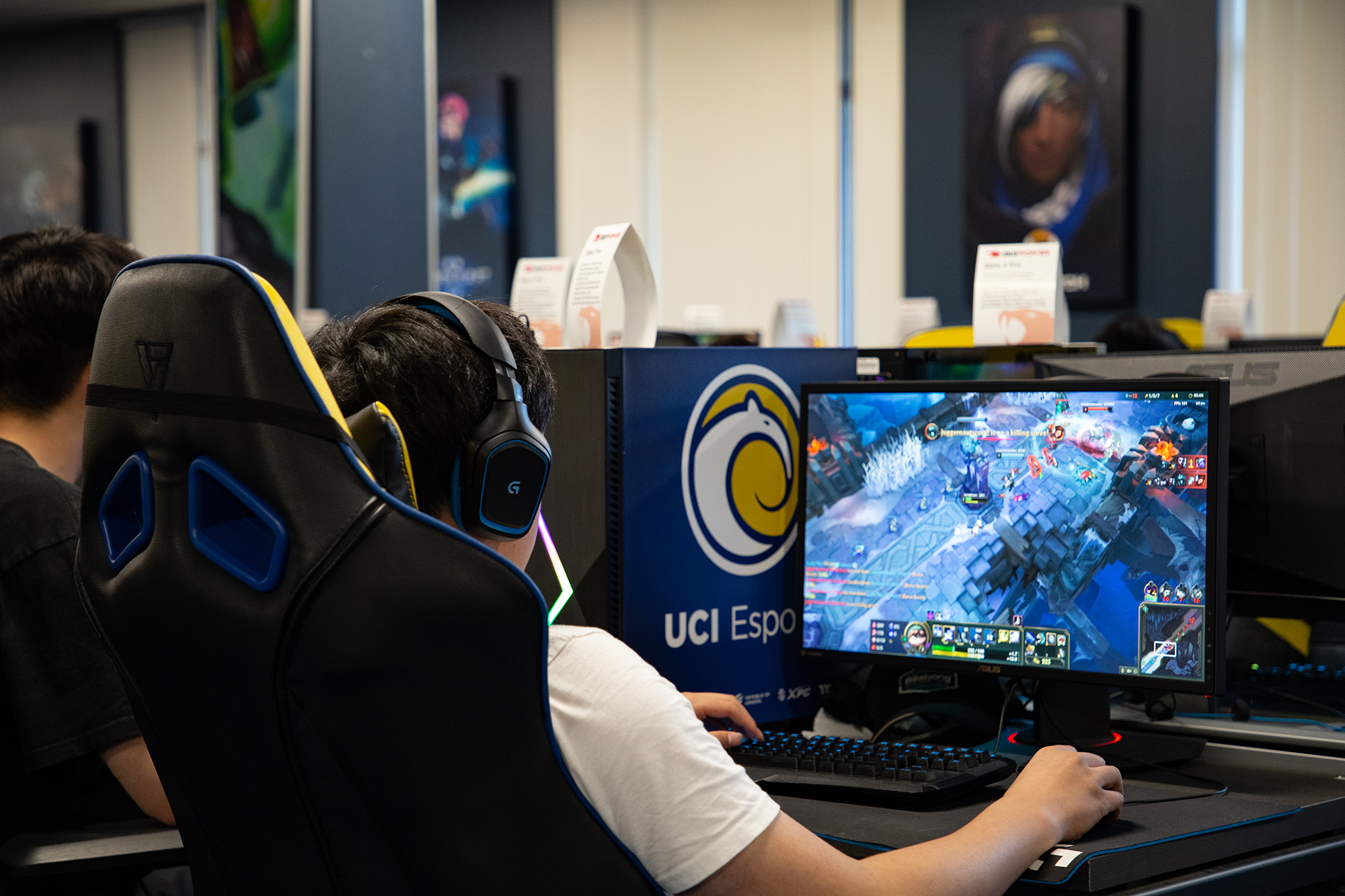
Institutional support for esports is on the rise, with schools like the University of California, Irvine offering official programs with fully-outfitted esports arenas. (Photo by Tanner Puckett/Cronkite News)
ASU esports seeks official program status with more institutional support
By Jason Krell/Cronkite News |
PHOENIX – When Dani George was a freshman at Arizona State University, the only thing that kept her from transferring was esports. She was depressed and had no friends, she said, but discovering the ASU Esports Association turned her life around. Now a junior and the club’s vice president, George wants to transform the organization before she leaves.
Unlike George’s initial struggles as a freshman, the club’s problems have nothing to do with finding a sense of community. In fact, George said ASU Esports is the largest club on campus, with around 1,700 members. Members convene regularly at LAN parties, where they bring gaming setups and play together in person. They chat constantly on the club’s Discord server, which is broken up into different channels for almost every esport in existence. Many of their teams also compete at the highest level in collegiate esports. The way George describes it, ASU Esports is her family.
The club’s problem is ASU itself, it said, specifically what members perceive as a lack of institutional support. Although it receives the same financial help as any other club, George said ASU Esports is different than any other club. A few hundred dollars a semester for pizza parties and some T-shirts doesn’t help when the players on ASU Esports teams each have to pay hundreds of dollars a semester to compete.
The club faces these struggles at a time when global esports has exploded in recent years, with major events drawing in millions of viewers online. Total esports revenues surpassed $800 million in 2018, and is predicted to reach $2.96 billion by 2022, according to a 2018 report by Goldman Sachs.
What the students in the ASU Esports Association say they need is the same as what many other universities around the country have: space for their players and club members to game in, scholarships to help them finish their education and recognition for being one of the most accomplished organizations on campus. The ASU Esports Association wants to grow into something more.
Fighting to be more than a club
George alleged a strained relationship with an ASU administration that she said ranges from disinterested to outright hostile when it comes to esports. She took to Twitter to vent her frustrations and describe some of the comments made about esports players at an ASU meeting two years ago. George said she wasn’t at the meeting herself, but was told about the comments by an advocate for esports at ASU who was present.
It’s so disheartening to hear how much my university hates our Esports
club:( so many people from every part of the school have used almost every stereotype in the book as a reason to shut us down… I just want support man— Dani (@DaniGeorge_) September 5, 2019
Jennifer Hightower, vice president of Educational Outreach and Student Services, said she was not aware of any derogatory comments made by the ASU staff nor was she in any meetings where the comments alleged by George were made.
George said she received significant support from the larger collegiate community, but that it doesn’t fix the damage such attitudes inflict on the club’s members.
“This club is my child – these kids are like my kids,” George said. “I love them and support them, and seeing (ASU staff) just beat on these people is awful. If a student was doing that, they’d be calling student services for bullying. These are adults that are going out of their way to actively make this an unsafe space because they just don’t want (esports).”
George added that common stereotypes about the people who enjoy esports don’t accurately reflect the community she knows. Although many think of the esports fan as out of shape, straight, white men with an aversion to social situations, George stands in stark contrast to that as a bisexual woman who participated in four years of competitive high school cheerleading. She said many others in the club reflect that same level of diversity.
Despite the uphill battle, George and her fellow club members are committed to fighting for more support. In fact, she said not embracing esports goes against ASU’s charter, which strives for innovation. She pointed to a portion of a video published by ASU where associate athletic director Alonzo Jones says, “When we say we’re an institution that’s accessible and defined by who we include and not exclude, we’re also saying that we’re an institution that represents the world.”
For George, this contradicts the way the administration has treated the ASU Esports Association.
“Well, most people nowadays are gamers, whether it’s mobile gaming, whether it’s competitive PC gaming or console,” she said. “By actively saying no, you’re discriminating against the community and culture of gaming as a whole, and you are not living up to your charter expectations. So, I beg you, why are you saying these things if you can’t live up to them?”
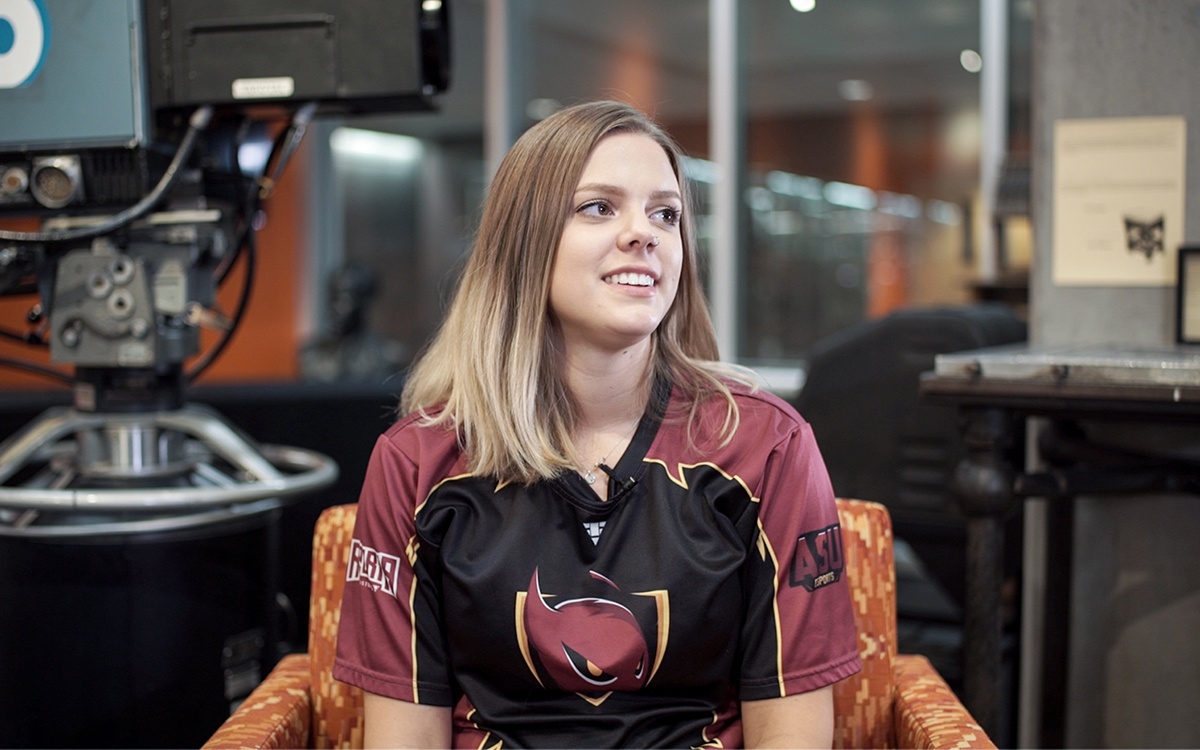
Dani George considered transferring from ASU after struggles with depression and an inability to find a good community, but her experience with the university's esports club convinced her to stay. (Photo by Tanner Puckett/Cronkite News)
Although ASU Athletics declined to comment for this story and the president’s office couldn’t be reached for an interview, Hightower, the vice president of Educational Outreach and Student Services, did lend her perspective about ASU esports.
As a club, ASU Esports falls under the umbrella of student services, and Hightower said the department has done a great deal for the organization’s students. She pointed to the gaming room EOSS built in the McClintock Hall dormitory after ASU won Heroes of the Dorm 2016 as an example. After those students demonstrated their high level skills at one of the largest collegiate esports tournaments in the world, Hightower said her office worked with them to give them a space to practice together.
In addition, Hightower said ASU worked with the Fiesta Bowl and Tespa, the branch of Blizzard Entertainment that oversees the company’s collegiate esports competitions, to host the 2018 Overwatch Collegiate National Championship. The event drew a sold out crowd to the Sun Devil Fitness Complex, where the four best college Overwatch teams in the country competed for that season’s title.
ASU and the University of Arizona’s teams competed in an exhibition match during the event. This is also the very thing that George said drew her into the ASU Esports Association in the first place. Based on these two instances, Hightower said the club has more support than most other clubs on campus.
“I think our level of commitment shows that we do have a really positive relationship with the esports community, that we want to grow that relationship with the esports community,” Hightower said. “We’re watching it as it grows and develops over time to see what are the things that students need. We wouldn’t have given them the kind of resources we’ve given them if we didn’t think that it was, you know, sort of a really valuable part of the student experience here.”
Somewhere in the middle, faculty associate John Pierce acknowledges that creating an official esports program is a complicated issue. Pierce teaches a class at the university on the business of esports and acts as an informal adviser to the club. He has also been deeply embedded in the larger collegiate esports community.
Pierce said creating an esports program requires unusually dedicated student leaders and staff members to create a plan and present it to the administration. With their attention stretched in so many directions, Pierce said administrators at ASU are unlikely to start the process themselves despite the genuine interest he’s seen.
“Any university is not likely to be sitting around going, ‘How do we do esports and come up with a plan,” Pierce said. “It takes somebody presenting the plan, because of a lack of understanding of the space, and mostly because people are busy.”
Fortunately, he said the students in the ASU Esports Association are capable of leading that effort. From what he said he’s seen, they’re one of the most engaged clubs on campus.
“I think that the passion that they have for gaming as a whole, the organizational work they do to organize competitions and to select teams is entirely unique to the esports association,” Pierce said. “I don’t think there’s a lot of other student organizations doing that kind of administrative and leadership type of work, and I think it’s representative of the passion for gaming on the ASU campus.”

The esports club was only recently able to get access to a small practice room, but only after several attempts emailing various administrators. Club leaders didn't know the room existed until last spring. (Photo by Jason Krell/Cronkite News)
Goals for a future esports program
So what, specifically, does George want from ASU? To start, she said she’d like a more responsive relationship with ASU’s administration. That means replying to emails, listening to the club’s expertise when it comes to esports or even just chatting over coffee on occasion. Having a high ranking staff member who showed genuine care for the club is her bare minimum.
“Every single email that I send out to an administrator, I literally have a Word document that explains esports in three sentences with six Forbes links, because I know that they don’t know,” George said. “And then even though I send them that, they still don’t even make the effort to understand it.”
After that, George said she wants a space where the club can feel welcome, like they have a presence on campus. Although ASU Esports does have the practice room that student services built, it’s small, with only six gaming setups. With far more than six players across all the club’s teams, George said the room doesn’t meet their needs.
Additionally, McClintock Hall was built in 1951 and has no elevator access. Since the room is in a corner of the dorm on the third floor, certain members of the club with disabilities can’t access the space. This also includes the club’s adviser, Theresa Devine, an associate professor in the New College of Interdisciplinary Arts and Sciences.
George also only realized these issues recently, since the club didn’t have access to the room until a few months ago. She said it sat unused for years because no one in ASU Esports knew the room existed until last spring. Even after they learned about it, George said they had to fight through a grueling and lengthy process to get access.
Hightower said the room’s placement in a dorm may have contributed to those difficulties, since student housing takes extra security measures to ensure student safety. She also attributes the decision to put the practice room in McClintock Hall to the difficulty of using a room for such a specific purpose when space is in such high demand on campus.
Hightower did admit that EOSS could do a better job staying keeping ASU Esports informed about the resources as their disposal.
“We just need to do a better job in the future of making sure that as those organizational transitions are happening, that we’re making sure that we’re working with the organizational leadership to find out who they want to have keycard access,” Hightowers said.
There’s more to meeting the club’s needs than open ears and more space, and George isn’t the only one who wants better for ASU Esports. The organization’s president, Jake Matson, said the club could also use more direct financial support to pay for league registration fees. Matson added many esports team members can’t afford to pay out of pocket to compete.
“That’s $50 some my kids don’t have,” Matson said. “My kids sometimes don’t have the $45 that it costs to buy our jerseys. Most of us are on loans or having to work a school job because we don’t have the money to pay for our tuition.”
Sometimes, the inability to shoulder these financial burdens costs students major opportunities. For example, ASU’s Rainbow Six Siege team is probably the best in their collegiate scene, sitting in first place across two separate leagues.

As a result, their performance this season was enough to earn an invitation to a tournament at DreamHACK Atlanta 2019, which would have been streamed nationally and given students the chance to compete with professional players.
Unfortunately, the team couldn’t afford the traveling costs. They set up a GoFundMe page to help reach their goal, but ultimately fell short and lost out on what ASU freshman and Rainbow Six Siege player Brandon Rocha said was an opportunity to advance a professional esports career.
“It sucks when you know that you could do so well, but you just can’t because it’s out of your control,” Rocha said. “That’s really the problem.”
All three members of ASU Esports, George, Matson and Rocha, also hope to one day see the university offer some form of scholarships for esports.
However, Hightower said her impression from the 2016 Heroes of the Dorm team is students want to be able to retain any potential cash prizes earned through collegiate competition. Turning esports into a varsity program and offering scholarships would require some changes, Hightower said, like giving up their ability to keep tournament payouts.
“If it was to become a varsity sport, that means it’s going to be an NCAA aligned sport, and we have to make sure we’re consistent with those policies and procedures,” Hightower said.
The NCAA currently does not run any esports leagues, nor does it have relationships with any of the tournament organizers who run esports leagues. There are also currently no amateurism rules in any major esports leagues that prevent players from benefiting financially while competing for a school.
Regardless, some students are conflicted about the possibility of giving up their winnings in exchange for potential scholarships. While League of Legends player Mason Cho said he would prefer to hold onto their ability to win prize money, head coach and ASU student Benjamin Duan would prefer the stability of scholarships.
The League of Legends team brought in around $20,000 in prize winnings last year, split between the entire team, but $14,000 came from placing third in the western conference of League of Legends developer Riot Games’ collegiate tournament. Duan acknowledged the team won’t always necessarily be able to maintain that level of performance.
“It really depends,” Duan said. “If we are at the top it’s more lucrative to have prize money. But if we were struggling, having that guarantee is better.”
Duan added that most of the money he takes home from his team’s success in these tournaments is reinvested into the team. He helps his players pay for expenses like event registration and team jerseys.
Fortunately for ASU Esports, Devine said the club has been making strides with support from herself and other allies in the School of Arts, Media and Entertainment. Just a couple weeks ago, Devine said faculty from multiple departments started discussions about creating an esports-focused curriculum. She added that there have even been exploratory discussions about giving the club more space on campus, though George declined to confirm this claim.
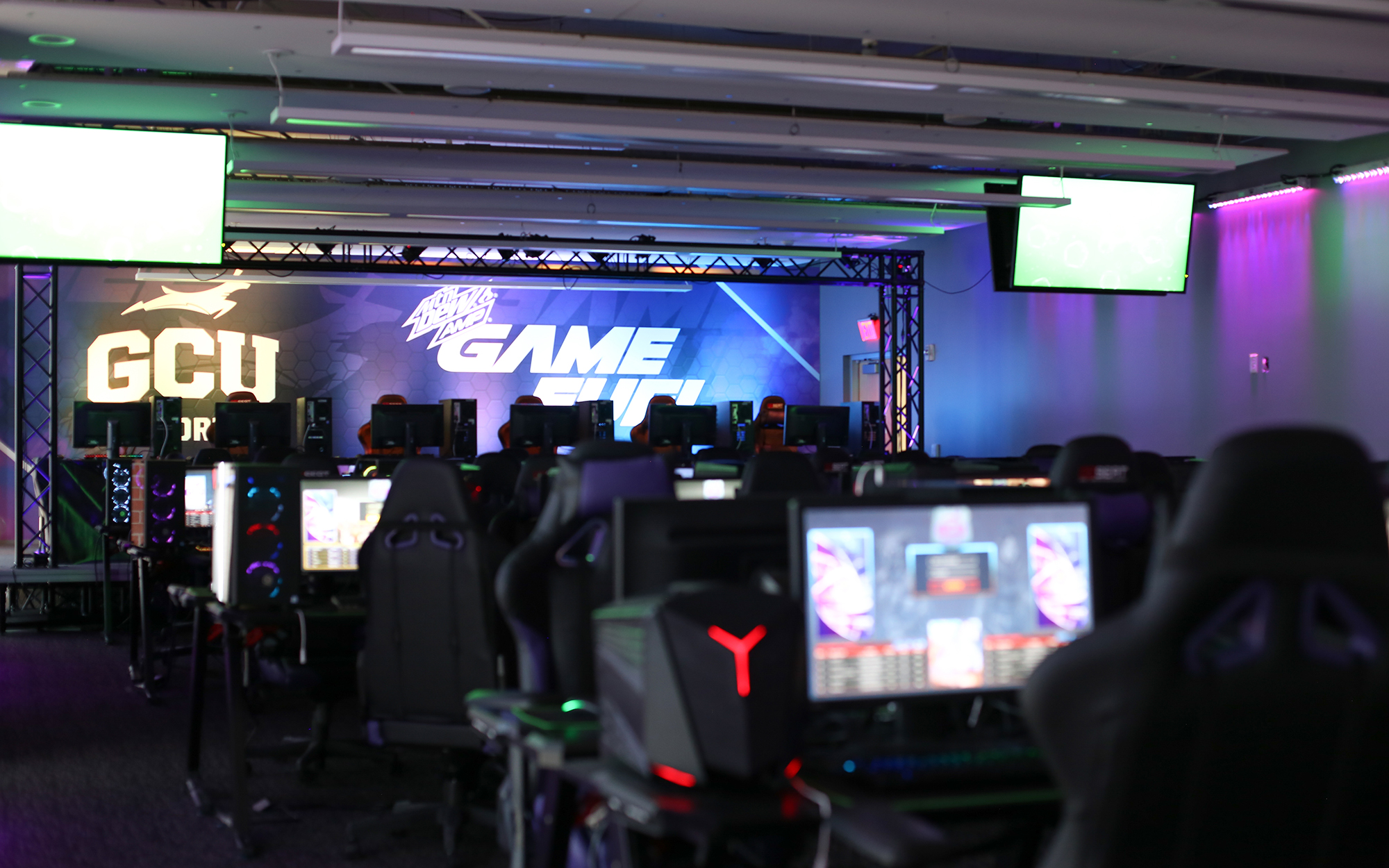
Grand Canyon University's esports arena accommodates up to 150 visitors at a time, including all the equipment necessary for club members to play or stream their gameplay. (Photo by Tanner Puckett/Cronkite News)
Elsewhere, collegiate esports thrives
The support George, Matson and their fellow club members want from ASU isn’t based on wishful thinking. Varsity esports programs are popping up all across the U.S. at colleges like Illinois’ Robert Morris University or the University of California, Irvine.
There are even official varsity esports programs in Arizona, like the one run by Albert Lee at Grand Canyon University. He was hired as esports coordinator by the private university a year and a half ago after the administration decided to invest in their already vibrant esports community. The program has already achieved some of the goals set out by the administration, he said.
“As a part of the initiative, they’re looking toward can they get student engagement to rise? Can they get potential high schoolers who might come to GCU to be more interested in our campus because of the facility?” Lee said. “And over the course of the past academic year, we proved that.”
The esports program started small, with an initial, experimental investment of a practice room and 12 computers. Lee said that 12 computers turned into 18, then 22. Eventually, they completely renovated two rooms to create a 3,200 square foot esports arena that can accommodate up to 150 visitors at a time.
The arena is now one of the top three recruitment factors at GCU, according to Lee. Formal support has also created a swell in membership, going from 20-30 members to more than 900. While the space is certainly useful for GCU’s official teams, Lee said its goal is far broader than just serving as a place to practice.
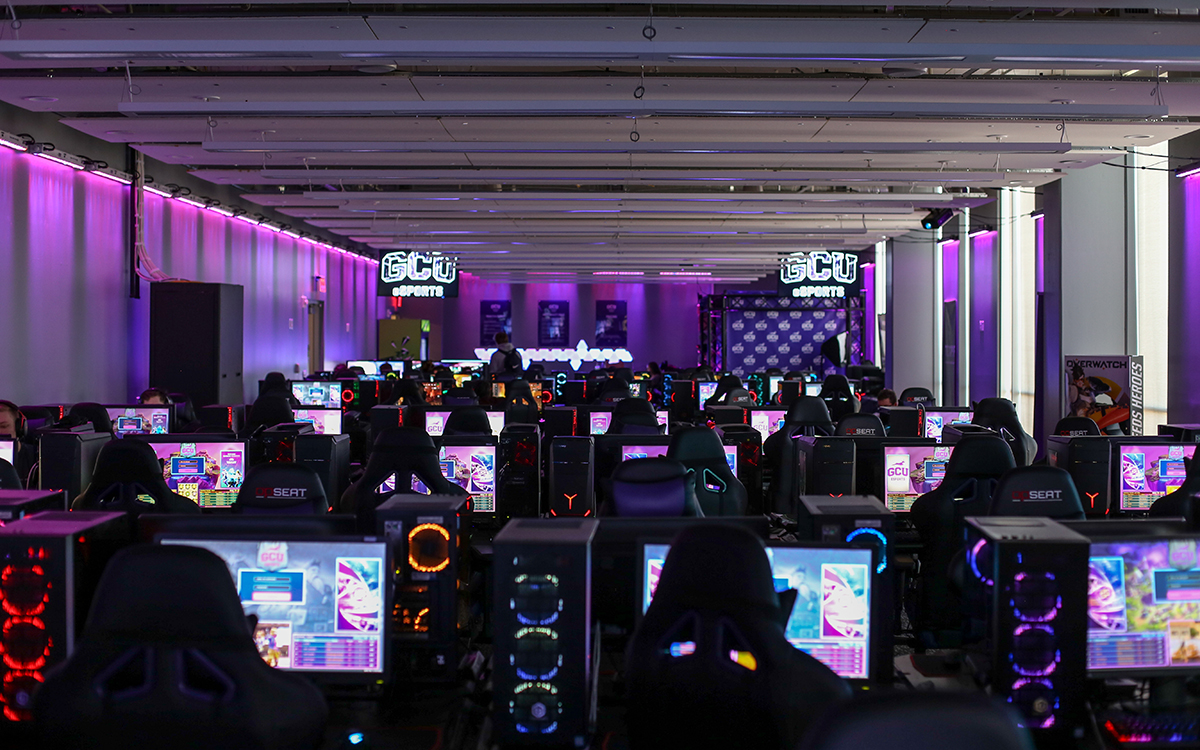
GCU's arena hosts practices for the university's competitive teams and scholarship students, but Lee said they emphasize including space for the club's casual players and building community. (Photo by Tanner Puckett/Cronkite News)
“This facility does support our competitive teams and we do offer them scholarships,” Lee said. “But we also support the casual players, the 900 to 1,500 now, that do play for fun, who are de-stressing and looking for new friends.”
Speaking of scholarships, Lee said this is the first year GCU has offered any to esports players. Although the amount of aid is currently small and only available to the League of Legends and Overwatch teams, the plan is to triple or quadruple them next year, all while expanding what teams are eligible to receive them.
Getting to this point wasn’t easy, though, and Lee said it required a unique approach. He stressed it is crucial for anyone trying to create their own esports program not to conflate it with traditional sports. Trying to determine the value of an esports team or market to interested students can’t be treated the same way as sports like football.
“I think that’s the biggest pitfall here, because esports is not just about the competitive teams,” Lee said. “It also has that community aspect. It has that connection between students trying to form a bond and passion over a shared experience.”
To avoid this misstep, Lee said student involvement in the decision making process is key. As the people most knowledgeable about esports and the needs of those in the community, shutting them out of the communication process can lead to uninformed decision making. Neither the students nor the administration can survive without help from the other.
“If the students don’t have administrative support, they don’t have the backing and the resources,” Lee said. “If administration doesn’t have the student support, they won’t ever truly know what they’re doing is successful, and they will have a harder time reaching out to prospects, because many prospects are looking for that sense of belonging.”
Outside of Arizona, schools like UCI have been heavily involved with esports for years. It launched its varsity program in 2016, when esports were still young at ASU, but brought together hundreds of students years earlier.
Kathy Chiang, UCI Esports’ assistant director, was one of the community’s original leaders back when it was just a club. She said they rode the wave of Riot Games’ push to bring esports into the mainstream. One of the club’s early major successes was hosting a viewing party for the 2014 League of Legends World Championship that drew 1,800 people to hangar to the OC Fair and Event Center.
The UCI Esports arena is open to all members of the student body and features both PC and console gaming options. (Photos by Tanner Puckett/Cronkite News)
Eventually, the various gaming clubs on campus consolidated into the Association of Gamers and found a staff ally in UCI Student Services, Mark Deppe. Chiang said Deppe had been looking into the success of esports while working on his master’s of business administration. Once he realized its potential, he helped the students build materials to present to the school’s administration. After connecting with the Vice Chancellor of Student Affairs, they started working toward making their official program a reality.
Edgar Dormitorio, the assistant vice chancellor of UCI student affairs, said that process was made easier by their willingness to listen to students, and by Deppe’s decision to champion the cause.
“I think one thing that we really pride ourselves on here at UCI is really being innovators, and being open minded about efforts like this, and also really listening to our students and what they want.” Dormitorio said. “And so because we have all of those factors on this campus, it was actually easy to talk to administrators, my colleagues and peers, to tell them, ‘Hey, this is the thing that students want to do.'”
Dormitorio also encouraged administrators at other institutions not to read too deeply into gamer stereotypes that might otherwise scare them away from esports. While he said there is some truth to issues in the community, he added that there is no better place than an academic institution to make a change. On the whole, Dormitorio said he thinks the esports program has been a positive force for the university.
These days, UCI’s program has two full-time staff members, five full-time contractors, 80 student workers and a vibrant esports arena. Their League of Legends and Overwatch have had access to scholarships, and they just created new ones for Super Smash Bros. Ultimate players.
A five-pillar focus on competition, academics and research, community, entertainment and careers ensures any who participate in UCI Esports get a well-rounded experience that prioritizes education. This also helps them effectively tackle major issues in esports, like toxicity and diversity.
As a result of their dedication, the university has become leading examples for esports programs in the country. Chiang said it is encouraging when they reach out to ask how they can recreate UCI’s success on their campus.
The arena was previously a pool hall. In addition to purchasing equipment, the university had to strip the previous space and retrofit it for internet and electricity requirements. (Photos by Tanner Puckett/Cronkite News)
“We get calls every week from different universities, community based organizations, even high schools and younger, that are looking to esports as a learning tool or a way to engage their students,” Chiang said. “So I’m very hopeful. I expect to see way more esports programs.”
That being said, Chiang acknowledged there was an element of luck to the program’s success. Multiple sponsors donated all the computers, monitors, peripherals and chairs, reducing the arena’s cost down to only a quarter of a million dollars. They also benefit from generous donors, like the Samueli Foundation, which funds a third of the program.
Other than the revenue generated from the esports arena, the program has no permanent funding. Chiang said that money is only enough to pay for the arena’s utilities costs plus her and Mark’s salaries. UCI Esports also doesn’t currently take any money from the university, though they are exploring options like requesting funding from student affairs or generating revenue in novel ways.
Regardless of the financials, Chiang said countless students have benefited from UCI Esports. Not only have many made lifelong friends, but others turned their experiences into successful careers in a growing industry.
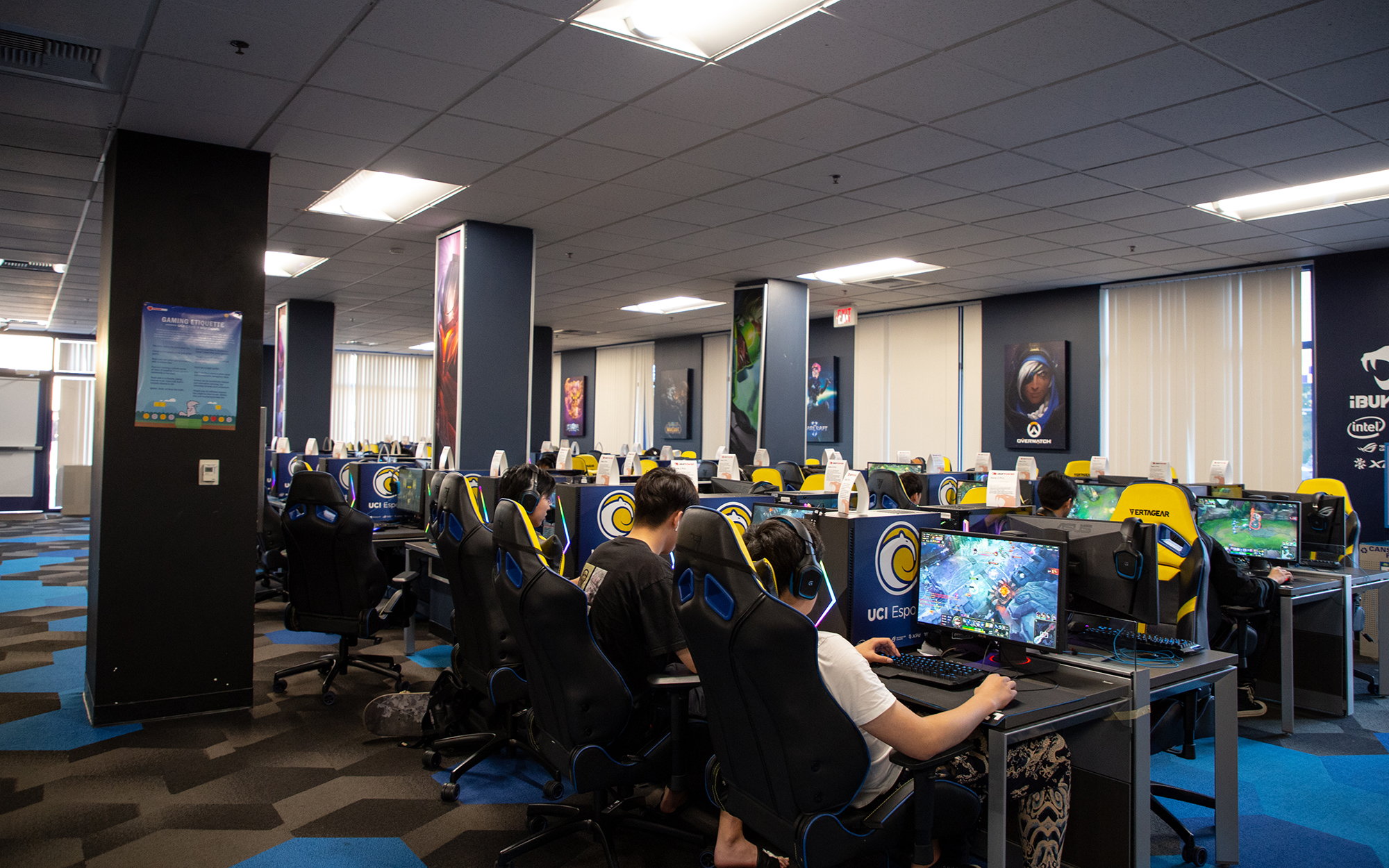
UCI has become a leader in the collegiate esports space, receiving calls from universities across the country every week for advice and information. (Photo by Tanner Puckett/Cronkite News)
Impact for college students
Participation in esports has led to many different kinds of success at different institutions. Lee said GCU students who are registered with the esports community have grades a few percentage points higher than the rest of the campus population. He attributes this to drawing gamers out of their digital worlds and into a larger community at the esports arena.
“But at many schools I know of, students might lock themselves up in their rooms and forget about doing homework or going to classes, right?” Lee said. “But the space brings you out of that room. It brings you out of that solitary confinement that you’ve kind of set yourself into, and now you’re part of this community where you’ll end up finding someone with similar interests and hobbies.”
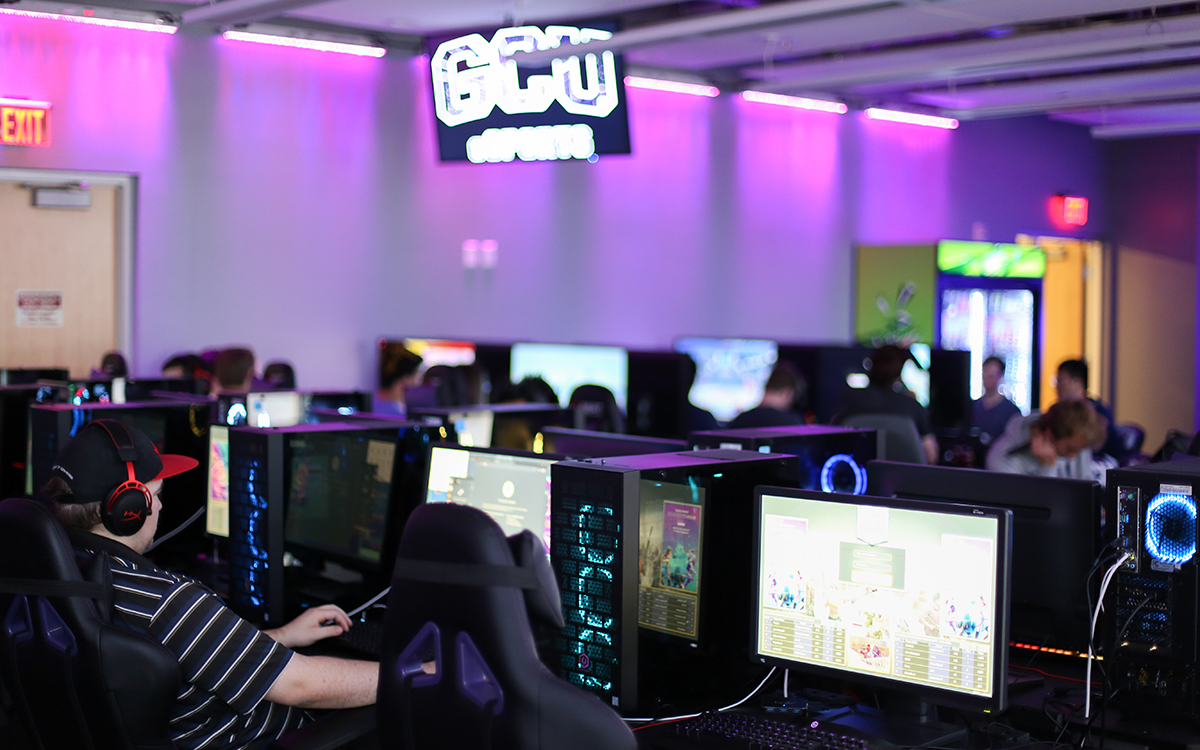
At UCI, Chiang said former students have landed jobs with major game developers, with professional teams, or in many other corners of the esports world. She attributes much of this to the opportunities available through UCI Esports.
To Pierce, this one of the main benefits of institutionally supported esports programs. They teach students leadership, teamwork, entrepreneurship, marketing, sales and recruitment, all while being held accountable for their grades.
“They go wide academically to create opportunities for students who were really interested in the space to have careers in the space when they finish, and to contribute back to society in a meaningful way versus having just sat around and played a bunch of games,” Pierce said.
The other side of the issue is that, without more support, many students in the ASU Esports Association face their own struggles. Rocha said he gets dirty looks when wearing his ASU Esports jersey around campus, and that he feels deeper support from the university could improve the attitudes of those on campus.
“There’s a lot of negative stigma toward the esports club just because we play video games, and people don’t recognize that it actually takes a good amount of dedication and hard work, if not more than other sports,” Rocha said. “Not as much physical, but a lot of hard work that most people can’t do.”
The lack of support has driven some potential students away from ASU, according to multiple people within the ASU Esports Association. Matson said he and George receive constant messages from high school students inquiring about whether ASU has scholarships or big opportunities for esports.
Others, like sophomore Rishi Raja have more personal stories. He is another one of ASU’s Rainbow Six Siege players, and earned a reputation at his former high school for being a college esports player. Earlier this year, a student still at that high school reached out to congratulate Raja and ask whether he should also come to ASU and play esports.
“I didn’t know what the hell to tell them,” Raja said. “I said ASU was one of the best in Arizona, one of the best in the United States, but we have no support. And that completely turned him off. I think right now he’s at UC Irvine.”
Matson also said the club’s leadership sometimes works 50-60 hours a week to keep all the teams in order, and that’s in addition to their academic obligations and any other jobs. Their club’s bank account also effectively consists of their personal bank accounts, as they’re constantly paying for odds and ends the club needs, like extension cables or power strips. This puts a heavy burden on their shoulders, but Matson said he doesn’t have any other choice.
“We do it because this is our family,” Matson. “This is the community we built. We have 1700 other family members here that we’re trying to provide for and I’m trying to provide for my 200 or 300 other family members that are playing on my teams. So that’s why I do it. Because if I didn’t do it, who’s going to do it?”
Unfortunately for George, she won’t be around to help next semester. She is leaving campus for a full-time job and will be finishing her degree online. While she said she plans to keep up with the team’s fight for more support, her ability to help will be limited from so far away. In the meantime, students like Matson and others will keep working toward a better future for esports at ASU.
Cronkite News reporters Tanner Puckett and Warren Younger contributed to this story.
Follow Cronkite News: Phoenix Sports on Twitter.

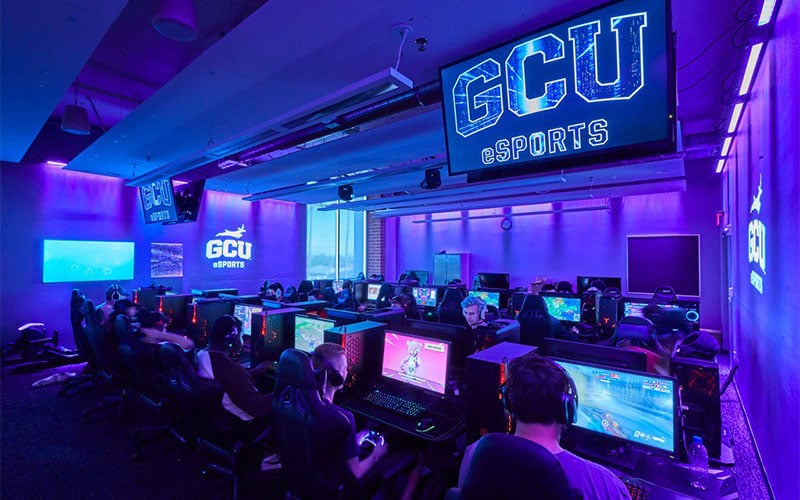

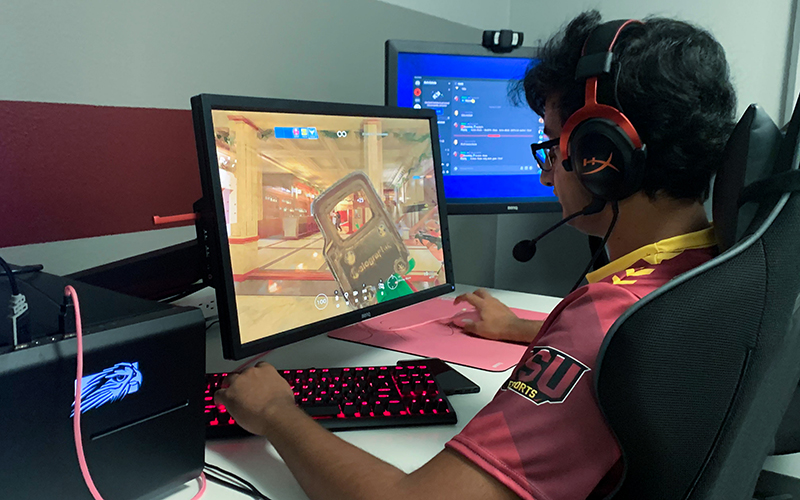


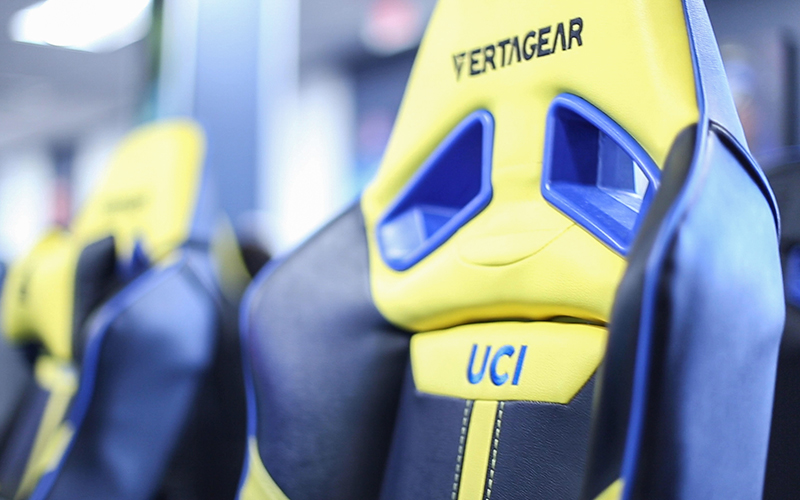
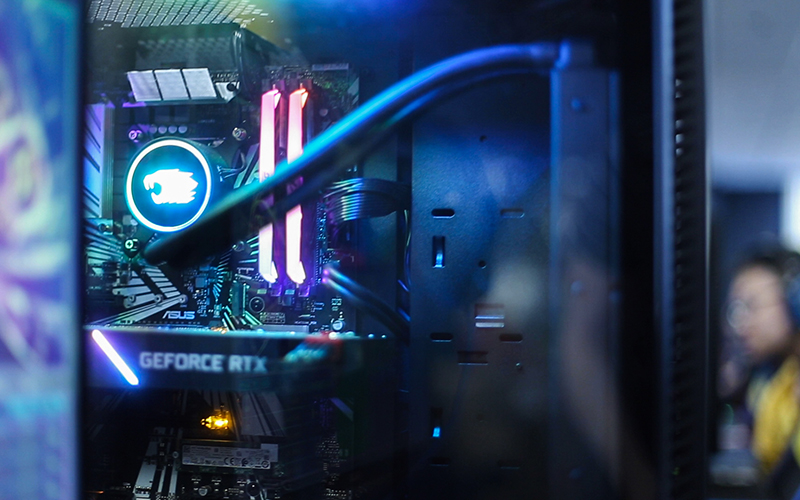
Leave a Comment
[fbcomments]